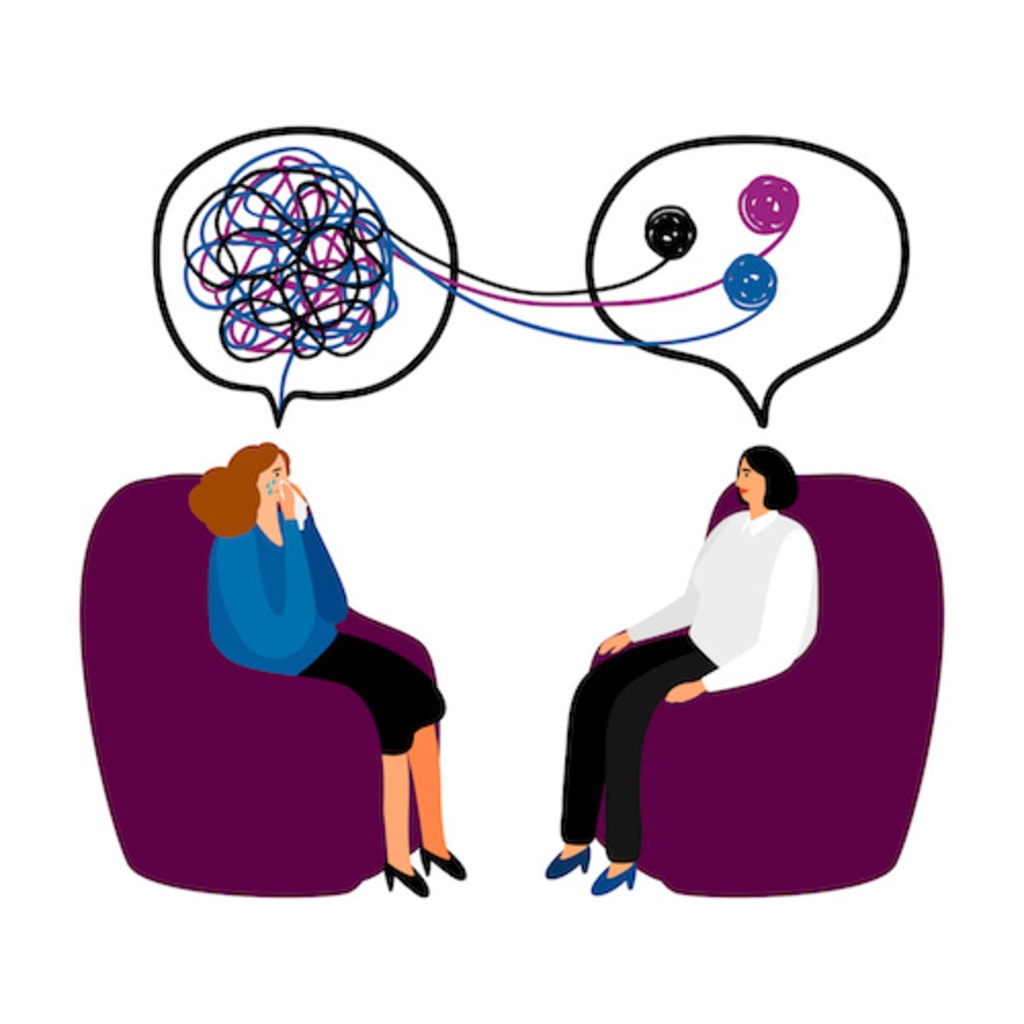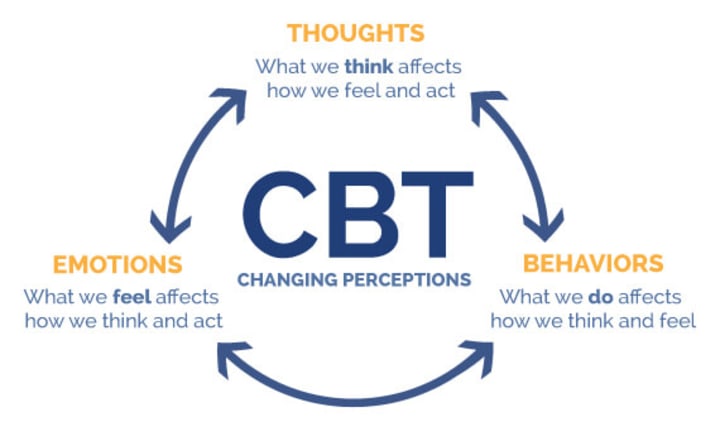Content warning
This story may contain sensitive material or discuss topics that some readers may find distressing. Reader discretion is advised. The views and opinions expressed in this story are those of the author and do not necessarily reflect the official policy or position of Vocal.
Exploring Different Therapy Options
Finding the Right Fit for You

If you've been experiencing persistent sadness, lack of motivation, irritability, anxiety, or a constant feeling of being on edge for weeks or months, it might be time to consider therapy. Seeking help is an important step towards improving your mental well-being and overall quality of life. However, with the wide range of therapy options available, it can be overwhelming to determine which one is best suited for your needs, especially if it's your first time seeking therapy. This article aims to provide insights into some commonly used therapies for mild depression, helping you make an informed decision about which approach might be most beneficial for you.
1. Cognitive Behavioural Therapy (CBT):
Cognitive Behavioural Therapy (CBT) is a widely recognized and evidence-based form of therapy that focuses on the relationship between our thoughts, feelings, and behaviors. It operates on the belief that our thoughts and interpretations of events influence our emotional and behavioral responses. By identifying and challenging negative or unhelpful thoughts and beliefs, CBT aims to create positive changes in our emotional well-being and overall functioning.
The underlying principle of CBT is that our thoughts can sometimes become distorted or biased, leading to negative emotions and maladaptive behaviors. These distortions, known as cognitive distortions, can include all-or-nothing thinking, overgeneralization, catastrophizing, personalization, and others. Through CBT, individuals learn to recognize these distortions and replace them with more realistic and balanced thoughts.

During CBT sessions, the therapist helps the individual identify and understand their negative thought patterns and how they contribute to their emotional distress. Through various techniques, individuals learn to challenge and reframe these thoughts, replacing them with more rational and adaptive alternatives. This process involves gathering evidence to support or refute their negative thoughts, exploring alternative explanations, and considering the impact of these new perspectives on their emotions and behaviors.
In addition to addressing thoughts, CBT also emphasizes the role of behaviors. It encourages individuals to engage in activities that they may have been avoiding due to their negative thoughts or low mood. By gradually increasing participation in enjoyable and fulfilling activities, individuals learn that their mood can improve, reinforcing positive behavior changes.
CBT is known for its active and collaborative approach. It involves homework assignments between sessions, where individuals practice applying the skills and techniques learned during therapy in their daily lives. These assignments may include keeping thought records, engaging in behavioral experiments, or practicing relaxation techniques.
While CBT is often associated with treating anxiety and depression, it has been successfully applied to a wide range of mental health conditions, including phobias, panic disorder, obsessive-compulsive disorder (OCD), post-traumatic stress disorder (PTSD), eating disorders, and substance abuse.
One of the strengths of CBT is its practicality and emphasis on developing skills that can be used beyond therapy. Individuals acquire tools and strategies to manage their thoughts and emotions effectively, allowing them to become more self-reliant in addressing future challenges. CBT equips individuals with lifelong coping skills, empowering them to maintain their mental well-being even after therapy concludes.
It's important to note that CBT is most effective when delivered by a trained and licensed mental health professional, such as a psychologist or therapist specializing in CBT. The therapist's expertise and guidance are crucial in tailoring the therapy to the individual's specific needs and facilitating the learning and application of CBT techniques.
Overall, Cognitive Behavioural Therapy provides a structured and practical approach to addressing negative thoughts, emotions, and behaviors. By fostering self-awareness and teaching individuals new ways of thinking and responding, CBT enables them to overcome challenges, improve their emotional well-being, and lead more fulfilling lives.
2. Short-Term Psychodynamic Psychotherapy:
Short-Term Psychodynamic Psychotherapy is a therapeutic approach that focuses on exploring the unconscious mind and understanding the impact of past experiences on present thoughts, emotions, and behaviors. It is based on the belief that unresolved or repressed conflicts and traumas can contribute to psychological difficulties.
Unlike traditional long-term psychodynamic therapy, which can extend over several years, short-term psychodynamic psychotherapy is a time-limited intervention. The therapy typically lasts between 12 to 25 sessions, with a specific focus on addressing the individual's presenting concerns within a condensed timeframe.
The core principle of short-term psychodynamic psychotherapy is to help individuals gain insight into the underlying causes of their difficulties. The therapist establishes a supportive and trusting therapeutic relationship, providing a safe space for the individual to explore their thoughts, feelings, and past experiences.
The therapy sessions involve an exploration of both current and past events, with a particular emphasis on identifying recurring patterns in relationships and interactions. The therapist assists the individual in connecting present struggles with unresolved conflicts or traumas from their past. By understanding the root causes of their challenges, individuals can gain new insights and develop strategies for coping and resolving emotional difficulties.
Short-term psychodynamic psychotherapy often utilizes techniques such as free association, dream analysis, interpretation of transference and countertransference, and exploring defense mechanisms. These techniques aim to uncover unconscious thoughts and emotions that may be influencing the individual's current experiences and behaviors.
A key goal of short-term psychodynamic psychotherapy is to facilitate change in problematic relationship patterns. The therapist helps individuals recognize how their past experiences may be influencing their current relationships and communication styles. Through insight and understanding, individuals can work towards healthier interpersonal dynamics and improved self-awareness.
Short-term psychodynamic psychotherapy differs from other therapies, such as cognitive-behavioral therapy, in its focus on the unconscious and the exploration of deeper emotional processes. While CBT emphasizes changing negative thoughts and behaviors, short-term psychodynamic psychotherapy seeks to delve into the underlying emotional conflicts and unresolved issues that contribute to psychological distress.
This therapy approach requires active participation and engagement from the individual. It involves self-reflection, exploration of thoughts and feelings between sessions, and openness to exploring unconscious material. The therapist acts as a guide, providing interpretations and insights, while also encouraging the individual to develop their own understanding of their experiences.
Short-term psychodynamic psychotherapy has been found to be effective in treating various mental health conditions, including depression, anxiety disorders, personality disorders, and relational difficulties. It offers individuals the opportunity to gain a deeper understanding of themselves, develop healthier coping mechanisms, and make positive changes in their lives.
It's important to note that short-term psychodynamic psychotherapy is typically provided by mental health professionals with specialized training in psychodynamic therapy. They have expertise in creating a safe and supportive therapeutic environment, facilitating exploration of the unconscious, and guiding individuals through the process of gaining insight and making positive changes.
In conclusion, Short-Term Psychodynamic Psychotherapy offers a focused and time-limited therapeutic approach that explores the unconscious mind, past experiences, and interpersonal dynamics. By gaining insight into unresolved conflicts and traumas, individuals can work towards resolving emotional difficulties, improving self-awareness, and fostering healthier relationships.
3. Behavioural Activation:
Behavioral Activation is a therapeutic approach that focuses on the relationship between a person's behaviors and their emotional well-being. It recognizes that our behaviors play a significant role in influencing our mood and overall functioning. Behavioral Activation aims to help individuals identify and engage in positive, meaningful activities that promote well-being and alleviate symptoms of depression or other mental health issues.
The core principle of Behavioral Activation is that depression and other psychological difficulties are often accompanied by a reduction in enjoyable and fulfilling activities. This decrease in engagement can lead to a downward spiral, where the lack of positive experiences further contributes to low mood and motivation. By targeting this behavioral withdrawal and promoting increased activity, Behavioral Activation seeks to reverse the cycle of depression.
During therapy, individuals work collaboratively with a therapist to identify and set specific behavioral goals that align with their values and interests. The therapist helps the individual explore activities that they once found pleasurable or meaningful but have since stopped engaging in. This could include hobbies, social interactions, exercise, or other activities that bring a sense of accomplishment or enjoyment.
Behavioral Activation focuses on gradually reintroducing and increasing the frequency of these activities in the person's life. The therapist and individual work together to create a structured plan for activity scheduling, incorporating new activities and reintegrating old ones. This process involves setting realistic goals, breaking tasks into manageable steps, and overcoming potential barriers or obstacles.
By participating in positive activities, individuals start to experience a sense of pleasure, achievement, and connection, which can counteract depressive symptoms. Engaging in rewarding behaviors also helps individuals build a sense of mastery and regain a sense of control over their lives.
Throughout therapy, individuals learn to monitor their mood and evaluate the impact of activities on their emotional well-being. This self-monitoring allows them to identify patterns, recognize the activities that have a positive effect on their mood, and adjust their behavior accordingly. It helps individuals become more aware of the connection between their activities and their emotional state.
Behavioral Activation differs from other therapies, such as Cognitive Behavioral Therapy (CBT), in that it primarily focuses on behavior change rather than directly targeting thoughts and beliefs. While CBT aims to modify negative thinking patterns, Behavioral Activation recognizes that behavioral change can also lead to improvements in mood and cognition.
This therapeutic approach is typically time-limited and structured, with a set number of sessions. However, the duration may vary depending on the individual's needs and progress. Behavioral Activation can be integrated into other therapeutic modalities or used as a standalone treatment, depending on the individual's preferences and the severity of their symptoms.
Behavioral Activation has been found to be effective in treating depression and has also shown promising results in addressing other mental health conditions, such as anxiety disorders and substance abuse. It is often used as part of a comprehensive treatment plan that may include other therapeutic interventions, such as medication or psychoeducation.
It's important to note that Behavioral Activation is typically delivered by mental health professionals, such as psychologists or therapists, who have training and expertise in this specific approach. The therapist's guidance, support, and monitoring are essential for successful implementation of Behavioral Activation techniques.
In summary, Behavioral Activation is a therapeutic approach that focuses on increasing engagement in positive and rewarding activities to alleviate depressive symptoms and improve overall well-being. By promoting behavior change, individuals can experience a sense of accomplishment, pleasure, and improved mood. Through collaborative work with a therapist, individuals learn to reintegrate meaningful activities into their lives, leading to long-lasting positive changes.

Person-Centred Therapy, also known as Client-Centred Therapy or Rogerian Therapy, is a humanistic approach to psychotherapy developed by psychologist Carl Rogers. It places emphasis on the individual's innate capacity for growth, self-actualization, and self-direction.
The core principle of Person-Centred Therapy is that individuals have the inherent tendency to move towards self-fulfillment and personal growth. The therapist creates a supportive and non-judgmental therapeutic environment where clients feel accepted, understood, and valued. The focus is on providing a safe space for individuals to explore their thoughts, feelings, and experiences, with the belief that they are the experts of their own lives.
In Person-Centred Therapy, the therapist adopts an empathetic and genuine attitude, seeking to understand the client's subjective experience and perspective without imposing their own interpretations or judgments. The therapist listens actively and reflects back the client's feelings and thoughts, facilitating the client's self-exploration and self-understanding.
The therapeutic process in Person-Centred Therapy revolves around the concept of unconditional positive regard. This means that the therapist accepts and values the client unconditionally, regardless of their thoughts, feelings, or behaviors. By experiencing this unconditional acceptance, clients can develop a greater sense of self-worth and self-acceptance.
Person-Centred Therapy encourages individuals to develop greater self-awareness and self-actualization by focusing on their own unique needs, desires, and values. The therapist assists clients in exploring their personal goals, values, and aspirations, empowering them to make choices and decisions that align with their authentic selves.
Unlike some other therapeutic approaches, Person-Centred Therapy does not provide specific techniques or interventions. Instead, it relies on the therapeutic relationship itself as the primary agent of change. The therapist's role is to create a safe and supportive environment that enables clients to tap into their own inner resources and make meaningful changes in their lives.
Person-Centred Therapy can be applied to a wide range of psychological difficulties, including depression, anxiety, relationship issues, self-esteem problems, and existential concerns. It is suitable for individuals of all ages, backgrounds, and cultures, as it respects and honors the unique experiences and perspectives of each client.
One of the key strengths of Person-Centred Therapy is its emphasis on empowering individuals to take control of their own growth and healing process. It recognizes that clients have the capacity to make positive changes when provided with a supportive and non-judgmental space for self-exploration and self-expression.
It's important to note that Person-Centred Therapy requires active participation and self-reflection from the client. Individuals are encouraged to engage in honest and open dialogue, expressing their thoughts and feelings freely. This therapeutic approach fosters self-acceptance, self-trust, and personal responsibility.
Person-Centred Therapy has been widely studied and has demonstrated positive outcomes in numerous research studies. It is recognized as an effective therapeutic approach, particularly in promoting personal growth, self-awareness, and improved psychological well-being.
Person-Centred Therapy is a humanistic approach to psychotherapy that prioritizes the client's innate capacity for growth and self-actualization. By providing an empathetic and non-judgmental therapeutic environment, clients are encouraged to explore their thoughts, feelings, and experiences, leading to greater self-awareness and personal growth. Through the therapeutic relationship, individuals can develop a stronger sense of self-worth, autonomy, and authenticity.
In Summary, choosing the right therapy is a crucial step towards addressing your mental health concerns. Each therapy option discussed in this article offers unique benefits and approaches to treatment. It's important to consider your preferences, the nature of your symptoms, and your readiness for self-reflection and structured interventions. Remember, therapy is a collaborative process, and finding a therapist with whom you feel comfortable and understood is key to a successful therapeutic journey. By taking this step towards seeking help, you are prioritizing your well-being and embarking on a path of self-discovery and healing.
About the Creator
Enjoyed the story? Support the Creator.
Subscribe for free to receive all their stories in your feed. You could also pledge your support or give them a one-off tip, letting them know you appreciate their work.





Comments
There are no comments for this story
Be the first to respond and start the conversation.